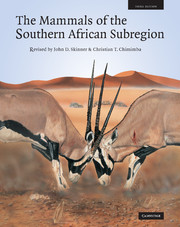Book contents
- Frontmatter
- Contents
- Editorial board
- Acknowledgements
- Foreword
- Preface
- The Mammal Research Institute
- R. H. N. Smithers
- Explanatory notes
- SUPERCOHORT AFROTHERIA
- COHORT PAENUNGULATA
- SUPERCOHORT EUARCHONTAGLIRES COHORT GLIRES
- COHORT EUARCHONTA
- SUPERCOHORT LAURASIATHERIA
- COHORT FERUNGULATA
- Bibliography
- Appendix 1 Conservation status of southern African mammals
- Appendix 2 Colloquial names
- Index of scientific names
- Index of English colloquial names
- List of subscribers
- Plate Section
- Plate Section
- Plate Section
- Plate Section
- Plate Section
- Plate Section
- Plate Section
R. H. N. Smithers
Published online by Cambridge University Press: 05 July 2013
- Frontmatter
- Contents
- Editorial board
- Acknowledgements
- Foreword
- Preface
- The Mammal Research Institute
- R. H. N. Smithers
- Explanatory notes
- SUPERCOHORT AFROTHERIA
- COHORT PAENUNGULATA
- SUPERCOHORT EUARCHONTAGLIRES COHORT GLIRES
- COHORT EUARCHONTA
- SUPERCOHORT LAURASIATHERIA
- COHORT FERUNGULATA
- Bibliography
- Appendix 1 Conservation status of southern African mammals
- Appendix 2 Colloquial names
- Index of scientific names
- Index of English colloquial names
- List of subscribers
- Plate Section
- Plate Section
- Plate Section
- Plate Section
- Plate Section
- Plate Section
- Plate Section
Summary
WHEN The Mammals of the Southern African Subregion was first published by the University of Pretoria in 1983 its author was Reay H. N. Smithers. Who was this man and how had he acquired so extensive a knowledge of the mammal fauna of southern Africa that allowed him to write the book? What follows is a brief overview of the life and work of this remarkable person.
Born on 26 October 1907 in Kenilworth, Cape Town, Reay Henry Noble Smithers went to school in Scotland and England, followed by two years of study at the University of Edinburgh. In those early years he acquired a gentle Scottish accent that remained with him throughout his life. He returned to Cape Town in 1928 and worked in a family business but soon realised that his strong preference was for natural history. So, in 1930, he joined an expedition to Angola, assisting with the production of a film and the collection of zoological and ethnographic specimens.
Returning to Scotland briefly, he arranged employment with the New York Botanical Gardens in 1932 as a field assistant, his assignment being to collect botanical specimens in the north-western Cape and South West Africa. He worked in collaboration with the Kirstenbosch Botanical Gardens and the plants that he collected were divided between the two organisations. For three consecutive years he won the Carthew Cup for the largest number of new plant species brought to Kirstenbosch.
- Type
- Chapter
- Information
- The Mammals of the Southern African Sub-region , pp. xiv - xviPublisher: Cambridge University PressPrint publication year: 2005

